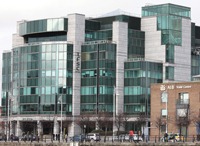Bank restructuring: An update
 Deleveraging targets are being met by Irish banks but some economists warn that too sharp a cutback in lending could slow growth. Meanwhile, the financial services sector has stabilised.
Deleveraging targets are being met by Irish banks but some economists warn that too sharp a cutback in lending could slow growth. Meanwhile, the financial services sector has stabilised.
The March 2011 bank restructuring strategy agreed that a prudential capital assessment review (PCAR) would place a minimum capital requirement of 10.5 per cent core tier 1 on the Irish banks and that a prudential liquidity assessment review (PLAR) would set deleveraging targets totalling €72.6 billion.
Ireland’s four banks and two building societies were reduced to three banks and one asset recovery bank. The two ‘pillar banks’ are Allied Irish Bank (AIB) and Bank of Ireland.
As a result of international investors taking a 35 per cent stake in BoI in July 2012, it is no longer in state control (as the Government’s shareholding is now 15 per cent). Fairfax Financial, Wilbur Ross, Fidelity Investments, Capital Group and Kennedy Wilson paid just over
€1.1 billion for a 35 per cent stake in the bank. Existing shareholders also took part in a private fundraising worth €600 million.
In July 2011, AIB acquired EBS building society, with EBS Limited to operate as a standalone, separately-branded subsidiary of AIB with its own branch network.
After the transfer of the business of Irish Nationwide Building Society to Anglo Irish Bank on 1 July 2011, the Irish Bank Resolution Corporation (IBRC) was formed.
Irish Life and Permanent was recapitalised on 31 July 2011 when the Government paid €2.9 billion. Its total capital requirement by 2014 is €4 billion. The Irish Life business is to be disposed of, while permanent tsb is reorganising its operations through three business units (permanent tsb, an asset management unit and its UK mortgage loan business, CHL). It will close 16 of its 92 branches, lose 250 full-time equivalent staff and invest in online banking.
The IMF’s September 2012 review has concluded that “banks’ deleveraging has continued to progress largely as planned under the PLAR, with €42 billion achieved by end April 2012 out of an indicative three-year target of €70 billion.” It added: “Together these developments allowed banks to taper down their reliance on ECB financing.”
On 17 October, Michael Noonan told the Finance and Public Expenditure and Reform Committee that total covered bank deleveraging to the end of June 2012 totalled €56.7 billion, comprising €44.6 billion at AIB, Bank of Ireland and PTSB, together with €12.1 billion in IBRC.
Deposit inflows at domestic banks are helping to gradually reduce the dependence on Central Bank funding, according to the Central Bank’s October 2012 quarterly review. However, that funding “still remains at a high level.”
The report warns: “Banks will have to continue adjusting their business models and reducing costs [but must] ensure that an adequate flow of credit to households and the SME sector is provided.”
A Financial Times editorial in August stated that “even the countries that have done the most in restructuring their banking sectors [i.e. Ireland and Spain] have gone nowhere near far enough.”
The author called for a policy that accelerates the shrinkage of bank balance sheets. However, it added: “Without safeguarding borrowers’ access to lenders that can provide credit, it can make things worse by stymieing those parts of the economy that should be driving the recovery.”
Financial services have also been hit by the Irish and global banking crisis. Corporation tax from companies that previously held the now defunct IFSC tax regime licence has dropped from €1.1 billion in 2007 to €466 million in 2011.
IBEC’s Director of Financial Services Ireland Brendan Bruen says that the international side of financial services here “has actually been doing reasonably well” with growth in funds. The insurance industry, however, has been experiencing difficulties due to tax changes in different jurisdictions and EU legislation like the Solvency II Directive, which imposes more demanding capital requirements. International banking has declined, he says, though individual markets within it, such as aircraft leasing, are seeing Ireland take “a leading position.”





